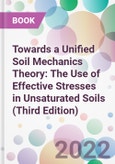Key Features
- Sequentially explains soil modeling techniques for easy understanding
- Demonstrates the use of an effective stress equation based on data from porous-solid models.
- Explains how porous-solid models can simulate the soilwater retention curves of materials.
- Establishes an elastoplastic framework for the volumetric behavior of unsaturated soils that is used to simulate the phenomenon of collapse upon wetting and the behavior of expansive soils.
- Explains the practical application of fully a coupled hydro-mechanical (critical state) soil model
- Includes scientific references for further reading
Towards A Unified Soil Mechanics Theory paves the way for a universal theory of soil mechanics that has a wide range of applications. The book is a valuable reference to civil engineers, geotechnical engineers, earth scientists and hydrologists interested in soil mechanics at both academic and professional levels.
Table of Contents
Chapter 1 Introduction1.1. Different Approaches For Unsaturated Soils
1.2. Effective Stresses
Chapter 2 The Effective Stress Equation
2.1. Introduction
2.2. The Effective Stress Equation
Chapter 3 The Porous-Solid Model
3.1. Introduction
3.2. Different Porous-Solid Models
3.2.1. Distinct Element Models
3.2.2. Random Models
3.2.3. Network Models
3.3. The Network Model
3.4. Mechanisms Of Wetting And Drying
3.4.1. Main Drying Curve
3.4.2. Main Wetting Curve
3.4.3. Secondary And Scanning Curves
3.5. Effective Stress Parameters
Chapter 4 The Probabilistic Porous-Solid Model
4.1. Introduction
4.2. The Probabilistic Model
4.3. Main Wetting Curve
4.4. Main Drying Curve
4.5. Saturated And Dry Volumes
4.6. Scanning Curves
4.6.1. Drying -Wetting Cycle
4.6.2. Wetting-Drying Cycle
4.7. Assessment Of The Probabilistic Model
4.8. Parametric Analysis
Chapter 5 Applications Of The Porous-Solid Model
5.1. Introduction
5.2. Mercury Intrusion Porosimetry Tests
5.3. Soil-Water Retention Curves
5.4. Obtaining The Pore Size Distribution
Chapter 6 Compression Strength Of Soils
6.1. Introduction
6.2. Numerical And Experimental Comparisons
Chapter 7 Tensile Strength
7.1. Introduction.
7.2. Tensile Tests
Chapter 8 Volumetric Behavior
8.1. Introduction
8.2. Proposed Equation
8.3. Elastoplastic Framework
8.4. Numerical And Experimental Comparisons
8.4.1. Tests By Fleureau Et Al.
8.4.2. Tests By Futai And Almeida
8.4.3. Tests By Cunningham Et Al.
8.4.4. Tests By Thu Et Al
Chapter 9 Collapse Upon Wetting
9.1. Introduction
9.2. Volumetric Elastoplastic Framework
9.3. Compacted Soils
9.4. Numerical And Experimental Comparisons
Chapter 10 Expansive Soils
10.1. Introduction
10.2. Background
10.3. Extended Elastoplastic Framework
10.4. Experimental And Numerical Comparisons
10.4.1. Tests By Romero Et Al.
10.4.2. Tests By Alonso Et Al.
Chapter 11 Hydro-Mechanical Coupling
11.1. Introduction
11.2. Procedure
11.3. Numerical And Experimental Comparisons
11.3.1. Tests By Chiu And Ng
11.3.2. Tests By Ng And Pang
11.3.3. Tests By Sun Et Al.
Chapter 12 A Fully Coupled Critical State Model
12.1. Background
12.2. Critical State
12.3. General Elastoplastic Framework
12.4. Mechanical Model
12.5. Numerical And Experimental Comparisons
12.5.1. Tests By Futai And Almeida
12.5.2. Tests By Cui And Delage
12.5.3. Tests By Garakani Et Al
Chapter 13 Retention Curves In Deforming Soils
13.1. Introduction
13.2. Procedure
13.3. Modeling The Swrc
13.3.1. Tests By Gao Et Al.
13.3.2. Tests By Salager Et Al.
Chapter 14 Undrained Tests
14.1. Introduction
14.2. Numerical And Experimental Comparisons
14.2.1. Tests By Jotisankasa Et Al.
14.2.2. Tests By Sun Et Al.
Chapter 15 Compacted Soils
15.1. Introduction
15.2. Elastoplastic Framework
15.3 Numerical And Experimental Comparisons
15.3.1. Tests By Sun Et Al.
15.3.2. Tests By Jotisankasa Et Al.
15.3.3. Tests By Tarantino And De Col
Chapter 16 Hydraulic Conductivity
16.1. Introduction
16.2. Capillary Flow
16.3. Numerical And Experimental Comparisons
- References
- Subject Index
Author
- Eduardo Rojas








